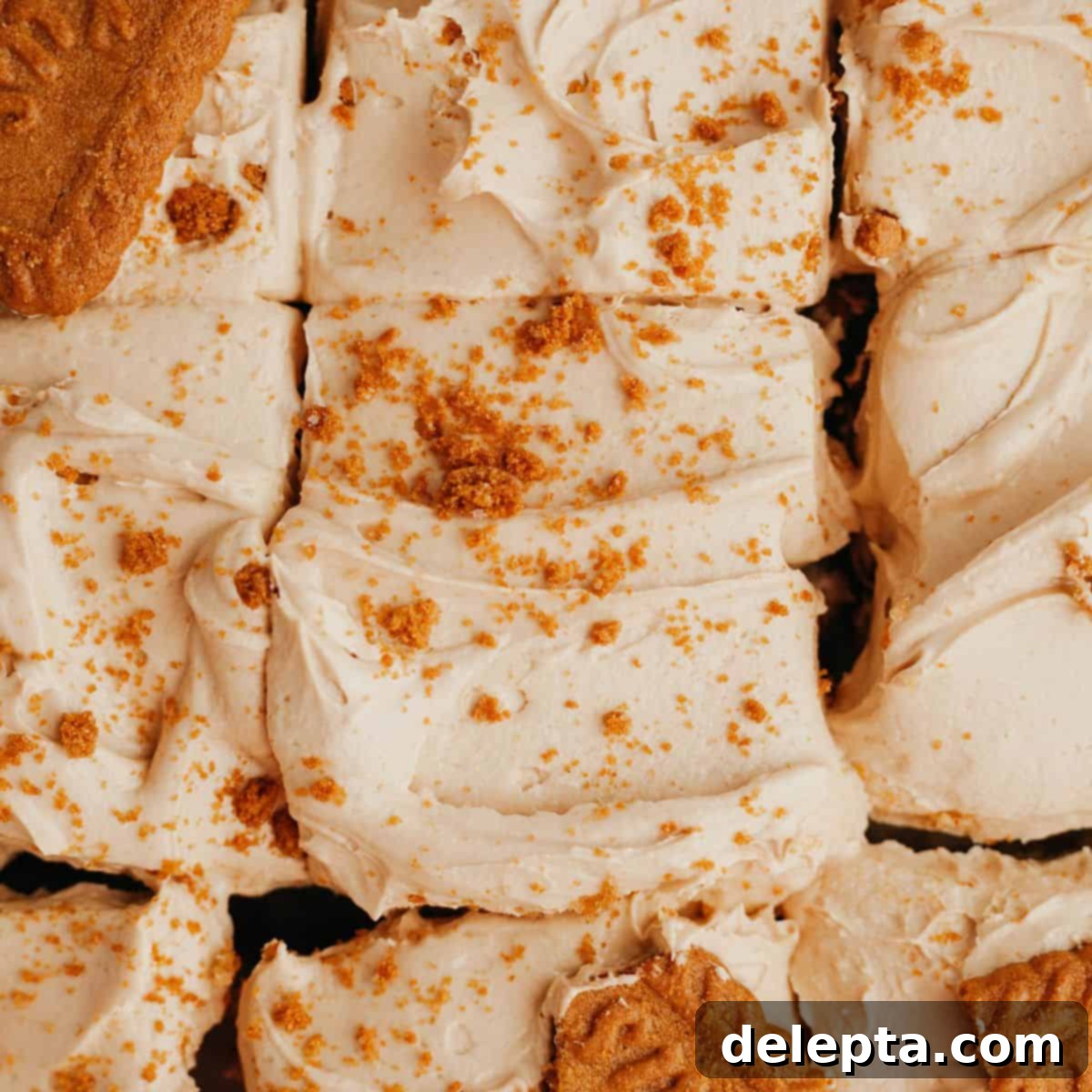The Ultimate Biscoff Buttercream: Your Dreamy Caramelized Cookie Butter Frosting
Prepare to fall in love with this incredible Biscoff buttercream, a rich and creamy frosting that tastes exactly like your favorite Speculoos cookies, transformed into a luscious spreadable delight. If you adore the distinctive caramelized spice flavor of Lotus Biscoff, then this easy cookie butter frosting recipe is about to become your new obsession. With just a handful of simple ingredients and minimal effort, you can effortlessly whip up this dreamy frosting to elevate any baked good.
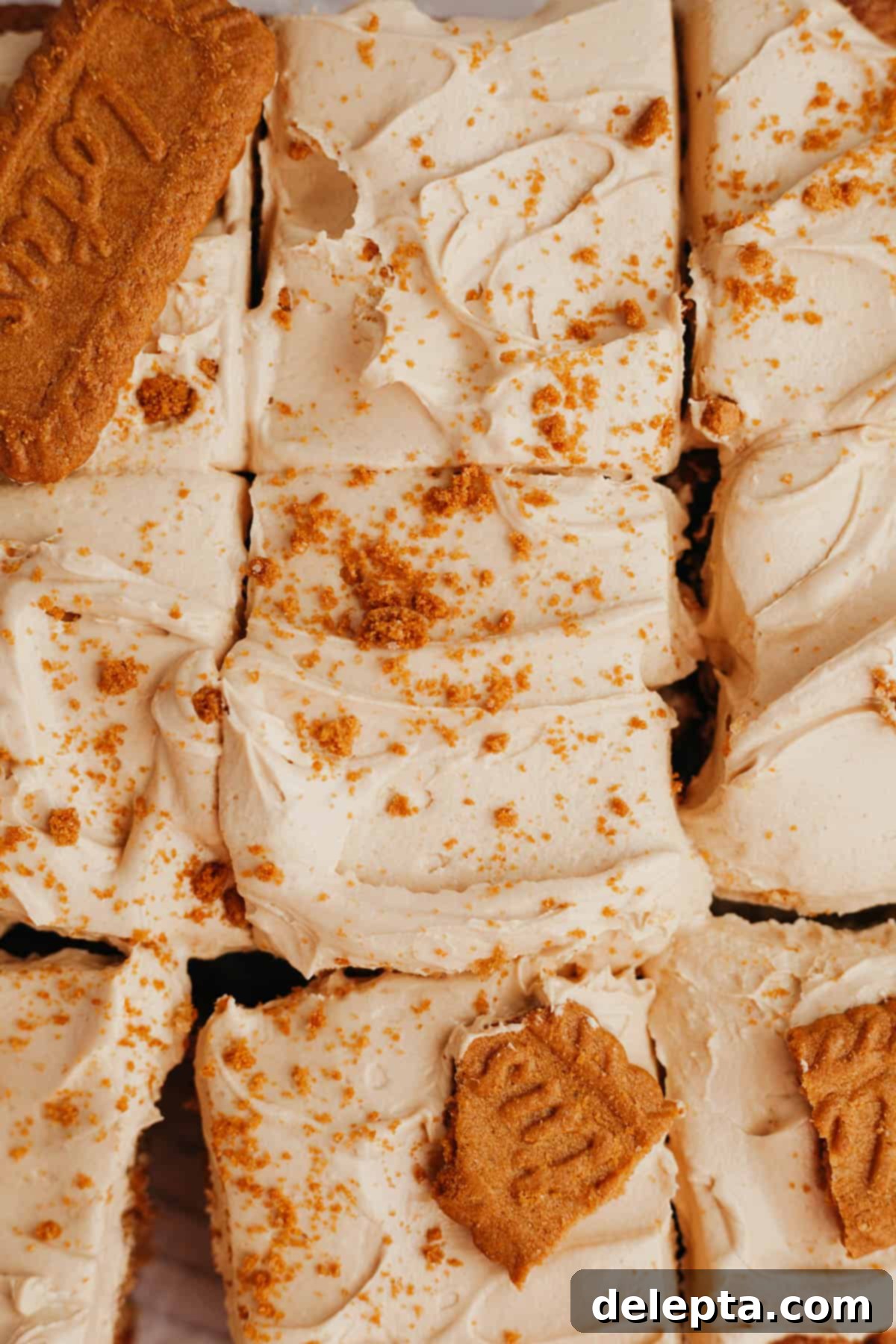
Lotus Biscoff spread truly holds a special place in the hearts of dessert lovers worldwide, and it’s certainly one of my absolute favorites! Its unique caramelized cinnamon taste is simply irresistible, which is why I’ve already shared popular recipes like my indulgent Biscoff cheesecake and a refreshing Biscoff milkshake. This particular Biscoff buttercream frosting is the secret ingredient I used to lavishly frost my Biscoff snack cake, creating a truly show-stopping dessert. However, its versatility knows no bounds; you can also use it to perfectly complement classic vanilla cake, rich chocolate cake, fluffy cupcakes, or even spread it between layers of brownies. Get ready to experience the magic of cookie butter in every delicious bite!
The foundation of this delectable recipe is a classic American buttercream, renowned for its straightforward preparation and delightful texture. This means it’s super simple to make and comes together in just a matter of minutes – no complex techniques or lengthy chilling times required. If you’re a devoted Biscoff fan, this really is the perfect recipe to satisfy your cravings and impress your friends and family with a unique, homemade frosting.
Why You’ll Adore This Biscoff Buttercream!
- Irresistible Cookie Butter Flavor: This cookie butter frosting is generously loaded with the star ingredient – Lotus Biscoff spread. This infuses every swirl with its distinct caramelized, cinnamon, and subtly spiced taste, reminiscent of the beloved Speculoos cookies. It’s a flavor that stands out and leaves everyone craving more!
- Effortlessly Easy to Make: Forget complicated techniques or a long list of obscure ingredients. You only need a handful of readily available components and a stand mixer (or a large bowl with a reliable handheld mixer). The entire process takes mere minutes, making it perfect for both novice bakers and seasoned pros alike.
- Incredibly Versatile for All Your Baking: This Biscoff buttercream is super versatile, making it the perfect companion for a wide array of treats. Use it to frost anything from classic vanilla cupcakes and rich chocolate cakes to vibrant red velvet cakes and delicate sugar cookies. It also makes a fantastic filling for whoopie pies, a topping for brownies, or even a delightful swirl on warm cinnamon rolls. The possibilities are truly endless!
- An Absolute Crowd Pleaser: Prepare for rave reviews! This Biscoff frosting is the ultimate crowd-pleaser, guaranteed to be a hit at any gathering. Its luxurious, creamy texture, paired with the utterly addictive and unique flavor of Biscoff, will make it the star of birthday parties, holiday celebrations, family get-togethers, or even your next bake sale. It’s a flavor experience everyone will remember and ask for again!
Essential Ingredients You’ll Need
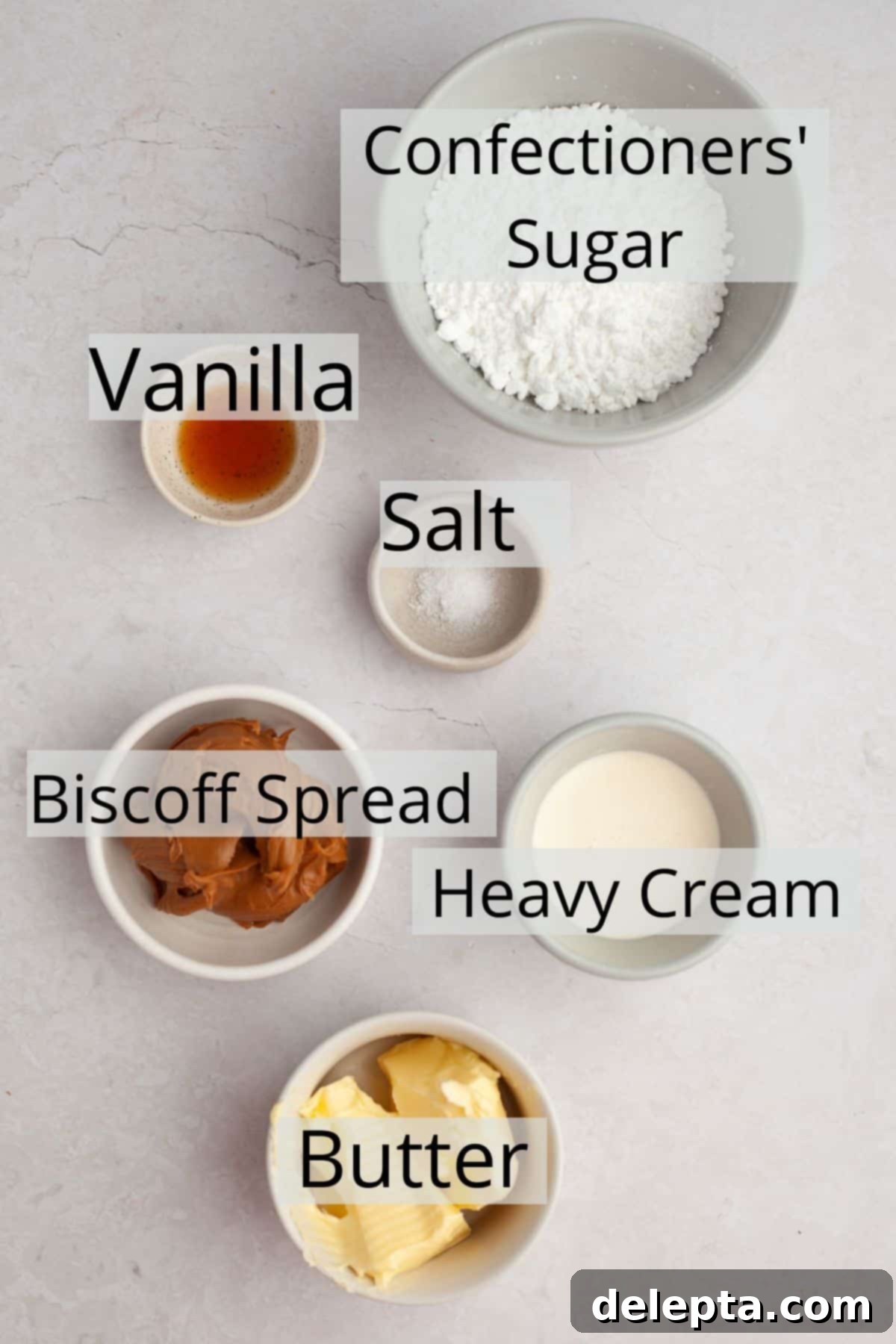
- Unsalted Butter: For this recipe, I always opt for unsalted butter, specifically European-style butter, which is known for its higher fat content. This results in a much richer, creamier, and more flavorful buttercream. Using unsalted butter also gives you complete control over the salt level in your frosting. Ensure your butter is at perfect room temperature before you begin – this is crucial for a smooth, lump-free consistency and proper aeration.
- Heavy Cream: A touch of heavy cream is your secret weapon for achieving that perfectly smooth, silky, and spreadable consistency that makes this frosting so luxurious. It helps loosen the buttercream while maintaining its richness. You’ll add this gradually to reach your desired texture.
- Lotus Biscoff Spread: The undeniable star of this show! This distinctive cookie butter spread infuses our frosting with its signature caramelized, subtly spiced, and deeply comforting flavor. You can readily find this iconic spread at major grocery stores like Target, typically located near the peanut butter and jams. Trader Joe’s also offers an excellent Speculoos cookie butter that works wonderfully as an alternative. *Important: Always ensure you are using the smooth version of the cookie butter, not chunky, to guarantee a perfectly silky frosting and prevent any issues if you plan to pipe it.*
- Confectioners’ Sugar: Also widely known as icing sugar or powdered sugar, this fine sugar is essential for both the sweetness and the structure of our buttercream. Sifting your confectioners’ sugar before adding it is a vital step to prevent any unwanted lumps or gritty texture, ensuring your frosting is wonderfully smooth and uniform.
- Vanilla Extract: A small amount of pure vanilla extract works wonders to enhance and round out the complex flavors of the Biscoff spread. It adds a subtle warmth and depth that complements the caramelized notes without overpowering them.
- Kosher Salt: A tiny pinch of kosher salt might seem insignificant, but it plays a critical role in balancing the sweetness of the sugar and Biscoff. It also helps to amplify and bring forward the delicious caramelized notes, preventing the frosting from tasting one-dimensionally sweet.
Effortless Step-by-Step Instructions
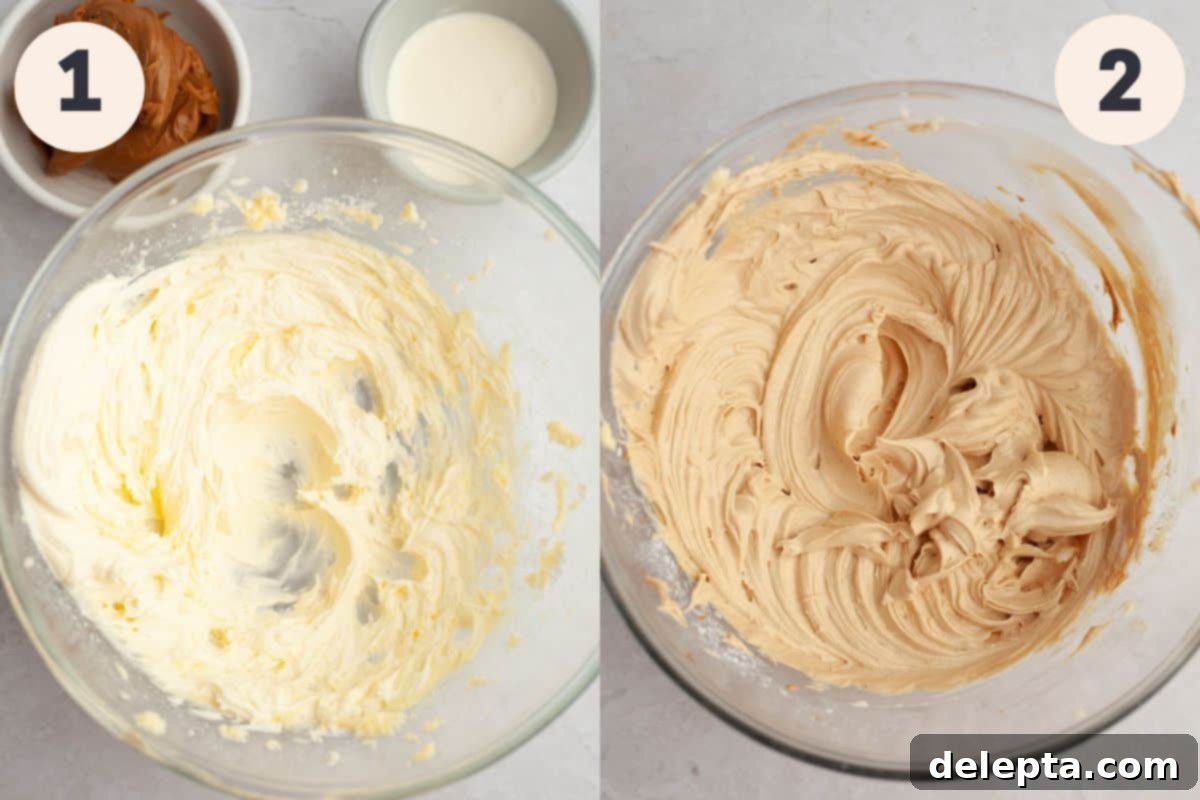
Creating this irresistible Biscoff buttercream is surprisingly simple. Follow these easy steps for a perfectly smooth and flavorful frosting every time:
Step 1: Cream the Butter and Sugar. In the bowl of a stand mixer fitted with the paddle attachment, or in a large mixing bowl if you’re using a handheld electric mixer, combine your softened, room-temperature unsalted butter with the sifted confectioners’ sugar. Begin mixing on a very low speed to prevent a “sugar cloud” from forming and sending powdered sugar flying. Once the sugar is mostly incorporated, increase the speed to medium-high and beat for 2-3 minutes. You’re looking for the mixture to become visibly lighter in color and wonderfully fluffy – this aeration is key for a light and airy buttercream.
Step 2: Incorporate Biscoff, Vanilla, and Salt. Next, add the smooth Lotus Biscoff spread, the pure vanilla extract, and the essential pinch of kosher salt to the bowl. Continue to mix on medium speed for another 2 minutes. During this stage, the frosting will transform into a beautiful, uniform beige color and fill your kitchen with the enticing aroma of caramelized cookies. Don’t forget to stop and scrape down the sides of the bowl periodically to ensure all ingredients are thoroughly combined and there are no pockets of unmixed butter or sugar.
Step 3: Achieve Perfect Consistency with Heavy Cream. Finally, it’s time to fine-tune the texture. With the mixer running on low speed, slowly drizzle in the heavy cream, adding one tablespoon at a time. Observe the frosting carefully as you add the cream. You’re aiming for a smooth, luxurious, and easily spreadable consistency that holds its shape well. Depending on factors like the humidity in your kitchen or your desired stiffness (e.g., for intricate piping versus simple spreading), you might need slightly more or less than the recommended amount. Stop when the frosting is perfectly soft enough to work with but firm enough to maintain its structure beautifully.
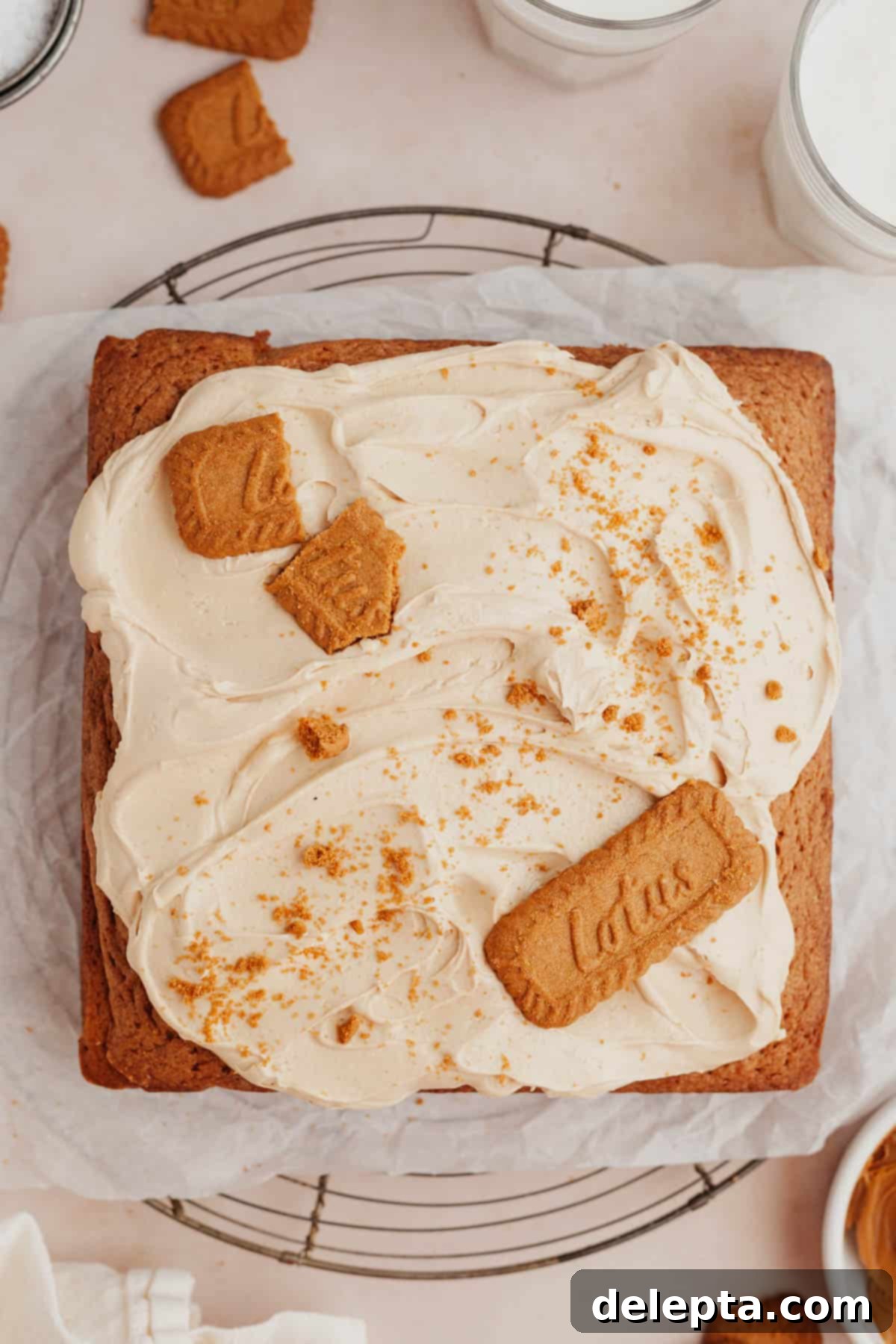
Expert Tips & Tricks for Perfect Buttercream
- Make sure your butter is at room temperature before you even think about starting this recipe. This is absolutely critical! Softened butter emulsifies much more easily with the sugar and other ingredients, preventing lumps and ensuring a beautifully smooth, fluffy, and aerated buttercream. If your butter is too cold, it won’t combine properly, and if it’s too warm, your frosting might be too thin.
- I highly recommend sifting your powdered sugar (confectioners’ sugar) before adding it to the butter. This simple step removes any small lumps that might be present, guaranteeing that your Biscoff buttercream is perfectly smooth and free of any gritty texture.
- When you first start mixing your powdered sugar and butter, begin on a very low speed. This tiny trick prevents the dreaded “sugar cloud” from erupting and coating your kitchen in a fine dusting of icing sugar! Mix on low until the ingredients are just combined, then gradually increase to medium speed.
- When it comes to adding your heavy cream, do it slowly and incrementally. Add a tablespoon at a time, mixing well after each addition, until the frosting reaches precisely the consistency you desire. This allows you to control the thickness and ensures your buttercream is perfect for spreading or piping.
- For a stunning presentation and an extra burst of Biscoff flavor, I love decorating the finished frosting. You can drizzle some melted Biscoff spread on top, or for a delightful crunch, sprinkle generously with crushed Biscoff cookies. A whole Biscoff cookie placed artfully on each cupcake also looks fantastic!
- Adjusting Consistency: If your buttercream feels too stiff after mixing, add a tiny bit more heavy cream (half a teaspoon at a time) until it’s perfect. If it’s too thin, you can add a tablespoon or two more sifted confectioners’ sugar, or refrigerate it for 15-20 minutes to firm up slightly before re-whipping.
- Enhanced Flavor: For an even more intense Biscoff flavor that melts beautifully into the frosting, you can gently warm the Biscoff spread slightly in the microwave (about 10-15 seconds) before adding it to the butter mixture. This small step helps it blend even more seamlessly into the buttercream base.
Frequently Asked Questions
Lotus Biscoff spread is crafted from Speculoos biscuits, renowned for their distinctive caramelized, slightly spicy flavor profile. Imagine notes of warm cinnamon, a hint of ginger, and a rich, deep caramel sweetness – it’s truly unique and incredibly addictive! Many describe it as a warm, cozy cookie flavor.
This incredibly versatile Biscoff buttercream elevates almost any dessert. It’s perfect for frosting a classic Biscoff cake, decadent chocolate fudge cupcakes, a rich chocolate layer cake, elegant vanilla layer cake, or even small batch vanilla cupcakes! Beyond traditional cakes, consider it for sandwiching between homemade cookies, filling for Whoopie Pies, topping for rich brownies, a delightful swirl on cinnamon rolls, or even as an unexpected dip for fruit. The possibilities are endless for this delightful cookie butter frosting!
For the smoothest, most pipeable frosting, I strongly recommend using the *smooth* version of Biscoff spread. The crunchy variety contains biscuit pieces that can clog piping tips if you’re decorating a cake or cupcakes, and it will result in a less uniform and slightly gritty texture in the frosting itself. If you love a crunchy element, it’s best to add crushed Biscoff cookies as a topping *after* the buttercream is applied, rather than incorporating them directly into the frosting.
This recipe yields a generous amount of frosting, enough to beautifully adorn an 8×8-inch snack cake with a thick, satisfying layer. It’s also perfect for lavishly frosting a dozen standard-sized cupcakes, creating impressive swirls and decorations. Alternatively, it provides a lovely, thick layer of frosting for an 8-inch two-layer cake. If you’re planning a larger baking project or prefer extra-tall, dramatic swirls, you might consider doubling the recipe to ensure you have plenty.
Achieving the ideal piping consistency involves a delicate balance. If your frosting feels too thick and stiff, add heavy cream very slowly, half a teaspoon at a time, mixing thoroughly between additions. If, conversely, it becomes too thin, a tablespoon or two of sifted confectioners’ sugar can help thicken it up. The key is to add very small amounts and mix well, observing how the texture changes until it holds a firm peak when lifted with a spoon, without being too stiff to pipe smoothly.
While this specific recipe uses dairy butter and heavy cream, you can absolutely adapt it to be vegan-friendly. Simply substitute the unsalted butter with a high-quality vegan butter stick (ensure it’s designed for baking and not a soft margarine spread). For the heavy cream, replace it with well-chilled, full-fat coconut cream (scoop only the thick cream from the top of the can) or a suitable vegan heavy cream alternative. Always double-check that your Biscoff spread is vegan, which it typically is, but labels can vary.
Storage Best Practices
To keep your leftover Biscoff buttercream fresh and delicious, store it in an airtight container in the refrigerator for up to 5 days. For longer storage, you can easily freeze it: simply place the buttercream in a freezer-safe, airtight container and store it in the freezer for up to 2 months. When you’re ready to use it after freezing, allow it to thaw completely in the refrigerator overnight. Once thawed, you may find that it needs a good stir or a quick re-whip with a mixer for a minute or two to restore its original smooth and fluffy consistency before you apply it to your baked goods.
Expand Your Biscoff Love with These Recipes!
- Biscoff Milkshake
- Oreo Frosting
- One Bowl Brown Butter Biscoff Blondies
- Biscoff Rice Krispie Treats
Have you made this irresistible Biscoff buttercream recipe? Please rate the recipe below and share your thoughts! Don’t forget to follow me on Instagram @alpineella and Pinterest to see more delicious creations!
Recipe Details
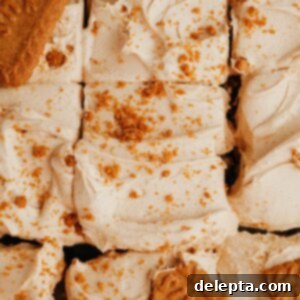
Biscoff Buttercream Frosting
Ella Gilbert
Pin Recipe
Save RecipeSaved!
Ingredients
For the Biscoff Frosting
- ½ cup unsalted butter softened to room temperature
- 1 cup confectioners’ sugar sifted, plus more if needed
- ¼ teaspoon kosher salt or less if using salted butter
- ½ cup Biscoff spread smooth version, gently warmed if desired
- 3-5 tablespoons heavy cream adjust to desired consistency
- 1 teaspoon vanilla extract
Instructions
-
In the bowl of your stand mixer fitted with the paddle attachment (or using a handheld mixer in a large bowl), combine the softened, room-temperature unsalted butter and the sifted confectioners’ sugar. Beat on low speed until just combined to avoid a sugar cloud. Then, increase the speed to high and beat for 2-3 minutes until the mixture is visibly light and fluffy.½ cup unsalted butter, 1 cup confectioners’ sugar
-
Add in the kosher salt, vanilla extract, and Biscoff spread (gently warmed if desired for easier blending). Beat again on medium speed for 2 minutes, scraping down the sides of the bowl as needed to ensure all ingredients are well incorporated and the frosting takes on a uniform color and irresistible aroma.¼ teaspoon kosher salt, ½ cup Biscoff spread, 1 teaspoon vanilla extract
-
With the mixer on low speed, add the heavy cream one tablespoon at a time until your frosting reaches the smooth, creamy, and spreadable consistency you like. Mix until just combined after each addition. Do not overmix.3-5 tablespoons heavy cream
Notes
Butter: Using a high-quality European-style butter, such as Kerrygold, will significantly enhance the creaminess and richness of your Biscoff buttercream due to its higher fat content.
Salt: If you don’t have kosher salt on hand, you can substitute with fine table salt, but remember to halve the amount called for in the recipe (e.g., ½ teaspoon fine salt for 1 teaspoon kosher salt). This helps prevent the frosting from becoming too salty.
Confectioners’ Sugar: This recipe uses approximately 1 cup of confectioners’ sugar as a starting point. However, if you find your frosting isn’t as thick as you’d like or if you prefer a sweeter taste, feel free to add more, about ¼ cup at a time, until you reach your desired consistency and sweetness. Remember to sift additional sugar.
Amount of Frosting: This recipe yields a generous batch of Biscoff buttercream, enough to generously frost an 8×8-inch snack cake, cover 12 standard-sized cupcakes with beautiful swirls, or provide a perfect thin layer of frosting for an 8-inch two-layer cake.
Storage: Store any leftover buttercream in a sealed, airtight container in the fridge for up to 5 days. For longer preservation, it can be frozen for up to 2 months. Make sure to thaw it completely in the refrigerator before using, and give it a good re-whip to restore its smooth consistency.
Nutrition Information
